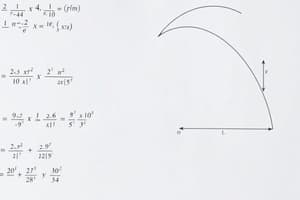Podcast
Questions and Answers
Which is the graph of f(x) = -(x + 3)(x + 1)?
Which is the graph of f(x) = -(x + 3)(x + 1)?
- Graph A
- Graph B (correct)
- Graph D
- Graph C
Which function has two x-intercepts, one at (0, 0) and one at (4, 0)?
Which function has two x-intercepts, one at (0, 0) and one at (4, 0)?
- Graph A (correct)
- Graph D
- Graph C
- Graph B
The graph of the function f(x) = (x - 4)(x + 1) is shown below. Which statement about the function is true?
The graph of the function f(x) = (x - 4)(x + 1) is shown below. Which statement about the function is true?
- Statement D (correct)
- Statement C
- Statement A
- Statement B
Which is the graph of f(x) = (x - 1)(x + 4)?
Which is the graph of f(x) = (x - 1)(x + 4)?
What is the axis of symmetry of the function f(x) = -(x + 9)(x - 21)? The axis of symmetry is x =
What is the axis of symmetry of the function f(x) = -(x + 9)(x - 21)? The axis of symmetry is x =
The function f(x) = −(x + 5)(x + 1) is shown. What is the range of the function?
The function f(x) = −(x + 5)(x + 1) is shown. What is the range of the function?
Which point is an x-intercept of the quadratic function f(x) = (x + 6)(x - 3)?
Which point is an x-intercept of the quadratic function f(x) = (x + 6)(x - 3)?
The function f(x) = (x − 4)(x − 2) is shown. What is the range of the function?
The function f(x) = (x − 4)(x − 2) is shown. What is the range of the function?
The graph of the function f(x) = (x + 2)(x + 6) is shown below. Which statement about the function is true?
The graph of the function f(x) = (x + 2)(x + 6) is shown below. Which statement about the function is true?
What is the y-intercept of the quadratic function f(x) = (x - 8)(x + 3)?
What is the y-intercept of the quadratic function f(x) = (x - 8)(x + 3)?
What is the y-intercept of the quadratic function f(x) = (x - 6)(x - 2)?
What is the y-intercept of the quadratic function f(x) = (x - 6)(x - 2)?
What is the midpoint of the x-intercepts of f(x) = (x - 2)(x - 4)?
What is the midpoint of the x-intercepts of f(x) = (x - 2)(x - 4)?
Which function has only one x-intercept at (−6, 0)?
Which function has only one x-intercept at (−6, 0)?
The graph of the function f(x) = (x − 3)(x + 1) is shown. Which describes all of the values for which the graph is positive and decreasing?
The graph of the function f(x) = (x − 3)(x + 1) is shown. Which describes all of the values for which the graph is positive and decreasing?
Flashcards
What are the x-intercepts of the graph f(x) = -(x + 3)(x + 1)?
What are the x-intercepts of the graph f(x) = -(x + 3)(x + 1)?
The graph of a quadratic function is a parabola. The x-intercepts of the function are the points where the graph crosses the x-axis. To find the x-intercepts, we set the function equal to zero and solve for x. In this case, the function is (x + 3)(x + 1) = 0. To make this equation true, one or both of the factors must be zero. Therefore, x + 3 = 0 or x + 1 = 0. Solving for x gives us x = -3 and x = -1. These are the x-intercepts of the function. Because the function is negative, the parabola opens downwards.
What are the x-intercepts of f(x) = (x - 4)(x + 1)?
What are the x-intercepts of f(x) = (x - 4)(x + 1)?
The x-intercept of a function is the point where the graph crosses the x-axis. At this point, the y-coordinate is always zero. To find the x-intercepts of f(x) = (x - 4)(x + 1), we set the function equal to zero and solve for x. That is, (x - 4)(x + 1) = 0. To make the equation true, either of the factors must be zero. So, x - 4 = 0 or x + 1 = 0. Solving for x, we get x = 4 and x = -1. Therefore, the x-intercepts of the function are (4, 0) and (-1, 0).
What is the axis of symmetry of f(x) = -(x + 9)(x - 21)?
What is the axis of symmetry of f(x) = -(x + 9)(x - 21)?
The axis of symmetry is a vertical line that divides the parabola into two equal halves. The x-coordinate of the axis of symmetry is equal to the average of the x-coordinates of the x-intercepts. In this case, the x-intercepts of f(x) = -(x + 9)(x - 21) are x = -9 and x = 21. The average is (-9 + 21) / 2 = 12 / 2 = 6. Therefore, the axis of symmetry is x = 6.
What is the range of the function f(x) = -(x + 5)(x + 1)?
What is the range of the function f(x) = -(x + 5)(x + 1)?
Signup and view all the flashcards
What is an x-intercept of the quadratic function f(x) = (x + 6)(x - 3)?
What is an x-intercept of the quadratic function f(x) = (x + 6)(x - 3)?
Signup and view all the flashcards
What is the range of the function f(x) = (x − 4)(x − 2)?
What is the range of the function f(x) = (x − 4)(x − 2)?
Signup and view all the flashcards
What is the y-intercept of the quadratic function f(x) = (x - 8)(x + 3)?
What is the y-intercept of the quadratic function f(x) = (x - 8)(x + 3)?
Signup and view all the flashcards
What is the y-intercept of the quadratic function f(x) = (x - 6)(x - 2)?
What is the y-intercept of the quadratic function f(x) = (x - 6)(x - 2)?
Signup and view all the flashcards
What is the midpoint of the x-intercepts of f(x) = (x - 2)(x - 4)?
What is the midpoint of the x-intercepts of f(x) = (x - 2)(x - 4)?
Signup and view all the flashcards
Which function has only one x-intercept at (−6, 0)?
Which function has only one x-intercept at (−6, 0)?
Signup and view all the flashcards
Which describes all of the values for which the graph of f(x) = (x − 3)(x + 1) is positive and decreasing?
Which describes all of the values for which the graph of f(x) = (x − 3)(x + 1) is positive and decreasing?
Signup and view all the flashcards
Which function has two x-intercepts, one at (0, 0) and one at (4, 0)?
Which function has two x-intercepts, one at (0, 0) and one at (4, 0)?
Signup and view all the flashcards
Which is the graph of f(x) = (x - 1)(x + 4)?
Which is the graph of f(x) = (x - 1)(x + 4)?
Signup and view all the flashcards
Which statement about the function f(x) = (x - 4)(x + 1) is true?
Which statement about the function f(x) = (x - 4)(x + 1) is true?
Signup and view all the flashcards
Which statement about the function f(x) = (x + 2)(x + 6) is true?
Which statement about the function f(x) = (x + 2)(x + 6) is true?
Signup and view all the flashcards
Study Notes
Quadratic Functions: Factored Form
- The function f(x) = -(x + 3)(x + 1) has a graph that opens downwards, indicating a maximum point.
- The function with x-intercepts at (0, 0) and (4, 0) represents a quadratic that crosses the x-axis twice.
- The function f(x) = (x - 4)(x + 1) shows characteristics such as x-intercepts and can be analyzed for key features.
- The graph of f(x) = (x - 1)(x + 4) features distinct x-intercepts that can be identified graphically.
- The axis of symmetry for f(x) = -(x + 9)(x - 21) is located at x = 6, dividing the graph into two symmetrical halves.
- The range of the function f(x) = −(x + 5)(x + 1) is determined by the maximum value since it opens downwards.
- For the function f(x) = (x + 6)(x - 3), identifying x-intercepts is crucial for understanding its roots.
- The range of f(x) = (x − 4)(x − 2) can be deduced from its vertex, as it opens upwards.
- The function f(x) = (x + 2)(x + 6) can be analyzed for true statements regarding its behavior and key attributes.
- The y-intercept of f(x) = (x - 8)(x + 3) can be calculated by evaluating the function at x = 0.
- The y-intercept for f(x) = (x - 6)(x - 2) is found by substituting 0 into the function.
- The midpoint of the x-intercepts for f(x) = (x - 2)(x - 4) provides insights into the vertex's horizontal position.
- A quadratic function that has only one x-intercept, such as (−6, 0), is termed a perfect square trinomial.
- The function f(x) = (x − 3)(x + 1) is characterized by specific intervals where it is positive and decreasing.
Studying That Suits You
Use AI to generate personalized quizzes and flashcards to suit your learning preferences.




